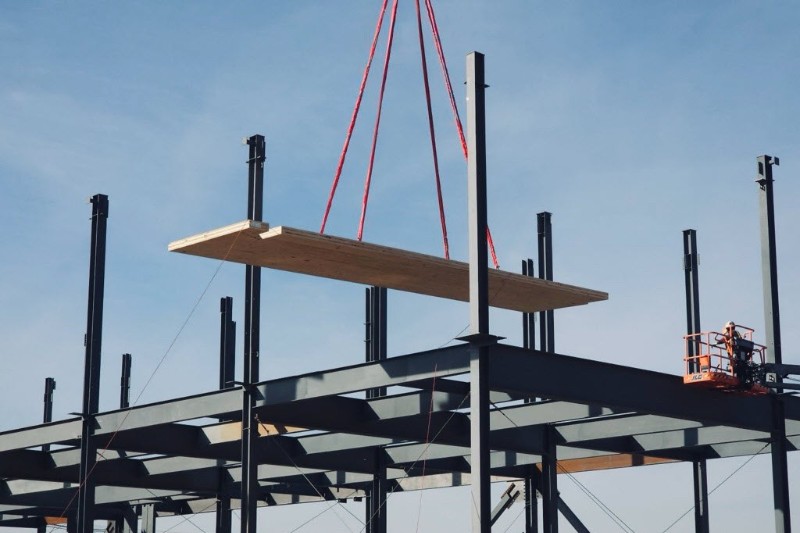

Cross-laminated timber adds sustainability in Microsoft’s datacentre build.
Microsoft’s latest construction venture in Virginia, USA, introduces a hybrid timber datacentre, designed to reduce embodied carbon by up to 65 percent compared to conventional concrete. This pilot project integrates cross-laminated timber (CLT) with steel and concrete, creating a mixed material framework that aims to replace traditional steel and concrete components in high-demand environments like datacentres. (main pic: Cross-laminated timber used in two new Microsoft datacentres under construction in northern Virginia.)
Using CLT – a fire-resistant, prefabricated material known for its strength and stability – this approach is broadly reflective of Microsoft’s commitment to innovative materials in large-scale, low-carbon construction. Microsoft has previously explored CLT in its Silicon Valley headquarters, but this is the company’s first datacentre constructed with engineered timber.
CLT Construction as a Path to Decarbonisation
This Virginia datacentre project marks part of Microsoft’s broader sustainability effort to become carbon negative by 2030. While the tech giant has achieved modest reductions in direct emissions, its indirect emissions – linked to material production, transport, and hardware – continue to climb. The timber datacentre model aims to address these emissions through a hybrid construction method, significantly cutting embodied carbon in structures designed for high-load data infrastructure.
Microsoft’s approach not only targets carbon reduction but also streamlines construction processes by reducing reliance on traditional materials with heavy embodied carbon, such as concrete and steel. In datacentres, which have strict requirements for structural integrity and fire resistance, the inclusion of CLT offers an efficient solution: it chars in a fire to create a protective layer, maintaining structural integrity under high heat better than steel.
Industry Collaboration and the Role of Offsite Timber Construction
The datacentre’s prefabricated timber components allow for offsite production, which can simplify construction timelines and minimise onsite labour, factors that are especially relevant as demand for datacentres continues to grow. The prefabrication process aligns with Microsoft’s offsite ambitions, adding another dimension to its low-carbon goals by reducing construction waste and energy use on site.
Microsoft has involved key structural and architectural experts in this datacentre project, including Thornton Tomasetti and Gensler, who have experience in low-carbon and modular solutions. Collaborating with these firms enables Microsoft to push forward a timber-based datacentre model that is both sustainable and capable of meeting the complex demands of hyperscale facilities.
Investing in Sustainable Supply Chains for Long-Term Impact
In addition to utilising CLT, Microsoft’s sustainability strategy includes extensive investment in alternative materials and technologies, through its USD $1 billion Climate Innovation Fund. The fund has targeted projects like hydrogen-powered steel production with Sweden’s Stegra and low-carbon concrete innovations with CarbonCure. By supporting companies in their transition to low-carbon material production, Microsoft is positioned to influence the development of greener construction practices industry-wide.
This investment extends beyond datacentres, aiming to decarbonise supply chains across multiple sectors. For builders and developers, Microsoft’s commitment highlights the growing importance of sustainable materials in the construction ecosystem, creating pathways for new green building solutions to scale.
Embracing Timber for Future Datacentre Builds
Microsoft’s pilot project in Virginia reflects a push towards timber as a sustainable choice for datacentre construction, potentially offering insights for developers and builders interested in implementing low-carbon materials at scale. As the adoption of CLT and other low-carbon alternatives expands, this model could pave the way for a future where high-performance facilities are constructed with a significantly lower environmental impact.
Source: Microsoft News